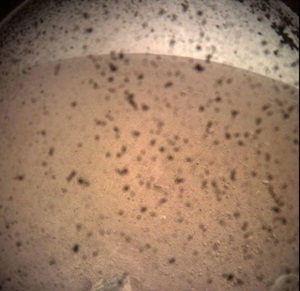NASA’s InSight spacecraft, the first robotic lander designed to study the deep interior of planetary bodies, touched down safely on the Martian surface on Monday with instruments to detect planetary seismic rumblings never measured anywhere but Earth.

Engineers at the Jet Propulsion Laboratory (JPL) at Pasadena, near Los Angeles burst into cheers, applause and hugs as they received signals confirming InSight’s arrival on Martian soil.
Minutes later, JPL controllers received a fuzzy “selfie” photograph of the probe’s new surroundings on the Red Planet, showing the edge of one lander leg beside a rock.
NASA's Interior Exploration using Seismic Investigations, Geodesy and Heat Transport (InSight) lander successfully touched down on the Red Planet after an almost seven-month, 300-million-mile (458-million-kilometer) journey from Earth.
InSight completed a thousand steps flawlessly to descent and land on the Martian surface, capping a six-month journey of 301 million miles (548 million km) from Earth.
InSight, during its two-year mission, will study the deep interior of Mars to learn how all celestial bodies with rocky surfaces, including Earth and the Moon, formed.
The InSight lander, launched from Vandenberg Air Force Base in California on 5 May, touched down near Mars' equator on the western side of a flat, smooth expanse of lava called Elysium Planitia, on 26 November, with a signal affirming a completed landing sequence at approximately noon PST (3 pm EST).
"Today, we successfully landed on Mars for the eighth time in human history,” said NASA administrator Jim Bridenstine. “InSight will study the interior of Mars, and will teach us valuable science as we prepare to send astronauts to the Moon and later to Mars. This accomplishment represents the ingenuity of America and our international partners and it serves as a testament to the dedication and perseverance of our team. The best of NASA is yet to come, and it is coming soon.”
The landing signal was relayed to NASA's Jet Propulsion Laboratory (JPL) in Pasadena, California, via one of NASA's two small experimental Mars Cube One (MarCO) CubeSats, which launched on the same rocket as InSight and followed the lander to Mars. They are the first CubeSats sent into deep space. After successfully carrying out a number of communications and in-flight navigation experiments, the twin MarCOs were set in position to receive transmissions during InSight's entry, descent and landing.
"We hit the Martian atmosphere at 12,300 mph (19,800 kilometers per hour), and the whole sequence to touching down on the surface took only six-and-a-half minutes," said InSight project manager Tom Hoffman at JPL. "During that short span of time, InSight had to autonomously perform dozens of operations and do them flawlessly — and by all indications that is exactly what our spacecraft did."
Confirmation of a successful touchdown is not the end of the challenges of landing on the Red Planet. InSight's surface-operations phase began a minute after touchdown. One of its first tasks is to deploy its two decagonal solar arrays, which will provide power. That process begins 16 minutes after landing and takes another 16 minutes to complete.
The InSight team expects a confirmation later Monday that the spacecraft's solar panels successfully deployed. Verification will come from NASA's Odyssey spacecraft, currently orbiting Mars. That signal is expected to reach InSight's mission control at JPL about five-and-a-half hours after landing.
"We are solar powered, so getting the arrays out and operating is a big deal," said Hoffman. "With the arrays providing the energy we need to start the cool science operations, we are well on our way to thoroughly investigate what's inside of Mars for the very first time."
InSight will begin to collect science data within the first week after landing, though the teams will focus mainly on preparing to set InSight's instruments on the Martian ground. At least two days after touchdown, the engineering team will begin to deploy InSight's 5.9-foot-long (1.8-meter-long) robotic arm so that it can take images of the landscape.































